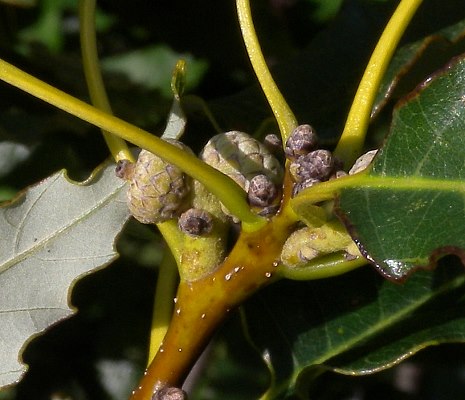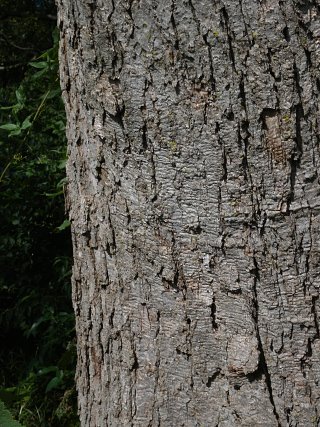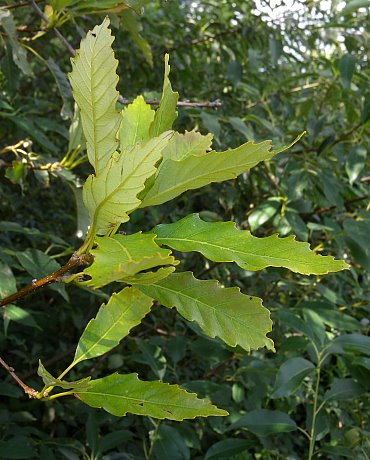
Chinkapin Oak is monoecious, producing separate male (staminate) and female (pistillate) flowers on the same tree. Male flowers are produced in drooping greenish yellow catkins (2-4" long) from twigs of the preceding year. Individual male flowers are less than 1/8" (3 mm.) across, consisting of an irregularly lobed hairy calyx and several stamens. Female flowers are produced individually or in very short spikes (with 2-3 female flowers) from the tips of the current year's twigs. Individual female flowers are about 1/8" (3 mm.) across and reddish green, consisting of a hairy ovoid calyx that surrounds an ovary with 3 stigmata at its apex. The flowers are cross-pollinated by the wind during mid- to late spring. Some female flowers become aborted, while others develop into acorns during the summer. At maturity during the autumn, these acorns are about ¾" long and ovoid in shape. Each mature acorn has a pale gray cap that is slightly tuberculate (bumpy or warty); it extends downward to about one-third the length of the acorn. The nut of a mature acorn is glabrous and brown to black; its interior contains white meat that is mildly sweet and edible. The root system consists of a taproot and spreading lateral roots. During autumn, the deciduous leaves become dull red or brown; a few leaves may persist on a tree during the winter.

Cultivation: The preference is full sun, mesic to dry-mesic conditions, and a mildly acidic to alkaline soil containing loam, silt-loam, clay-loam, or glacial till. Seedlings and young saplings have greater tolerance of shade than mature trees.
Range & Habitat: The native Chinkapin Oak is occasional throughout Illinois (see Distribution Map). Habitats include mesic to upland woodlands, rocky upland woodlands, thinly wooded bluffs, wooded slopes, savannas, limestone glades, and woodland borders along fields, roads, and parking lots. This tree is often associated with mineral-rich glacial moraines and rocky areas where limestone underlies the soil surface.
Faunal Associations: Chinkapin Oak and other oak trees attract many insects that feed on the leaves, suck plant juices, bore through the wood, etc. These insect feeders include the larvae of metallic wood-boring beetles, larvae of long-horned beetles, leaf beetles, weevils, larvae of bark beetles, larvae of gall flies, aphids, leafhoppers, treehoppers, armored scales, mealybugs, plant bugs, stink bugs, walkingsticks, larvae of gall wasps, larvae of sawflies, larvae of Duskwing skippers (Erynnis spp.), larvae of Hairstreak butterflies (Satyrium spp.), and larvae of many moths. The latter group of insects includes tiger moths, ribbed coccoon-making moths, case-bearer moths, Geometer moths, leaf blotch miner moths, lappet moths, slug caterpillar moths, midget moths, owlet moths, prominent moths, giant silk moths, clear-winged moths, trumpet leaf-miner moths, and Tortrix moths; see the Beetle Table, Aphid Table, Moth Table, and the Miscellaneous Insect Table. These insects attract many kinds of insectivorous birds, such as tanagers, warblers, and vireos.

Many kinds of birds have been observed to feed on the acorns of oak trees, especially oaks that produce smaller acorns. This include such birds as ducks, crows, blackbirds, woodpeckers, nuthatches, upland gamebirds, and even parakeets (the introduced Monk Parakeet and extinct Carolina Parakeet). The Bird Table provides a more detailed list of these species. Many mammals also feed on the acorns of these trees, including the Gray Fox, White-tailed Deer, Prairie Vole, Meadow Vole, White-footed Mouse, Virginia Opossum, Raccoon, Southern Flying Squirrel, Eastern Gray Squirrel, Fox Squirrel, American Red Squirrel, Eastern Chipmunk, Muskrat (minor), and American Black Bear. The White-tailed Deer also browses on the twigs and foliage, the Cottontail Rabbit gnaws on the bark of oak saplings, and the American Beaver feeds on the wood and bark when these trees occur near bodies of water (Martin et al., 1951/1961; Whitaker, 1966; Hamerstrom & Blake, 1939; Beeman & Pelton, 1980). Chinkapin Oak and other oak trees also provide protective cover for many kinds of wildlife. Birds that select oak trees for nesting sites include such species as the Red-shouldered Hawk, Cerulean Warbler, Hooded Warbler (saplings), Blue-gray Gnatcatcher, Eastern Wood-pewee, Yellow-throated Vireo, and Field Sparrow (saplings); see Dijak et al. (1990), Newell & Rodewald (2011), Bielefeldt & Rosenfeld (2001), and Best (1978). Bats often select oak trees as daytime roosting sites and sites for maternity colonies. This include such bat species as the Silver-haired Bat, Evening Bat, Big Brown Bat, Hoary Bat, Little Brown Bat, Tricolored Bat, Indiana Bat, and Northern Long-eared Bat (Perry et al., 2010; Perry & Thill, 2008; Swier, 2003; Baerwald et al., 2012; Veilleux et al., 2003; Carter, 2003). Sometimes old oak trees provide dens for mammals, such as tree squirrels, raccoons, and opossums.
Photographic Location: Edge of a wooded area at Weaver Park in Urbana, Illinois.

Comments: Across local populations, there is significant variability in the size and width of leaves, and also the hairiness and color of leaf undersides. The scientific name of Chinkapin Oak is sometimes spelled Quercus muehlenbergii. The common name of this tree is sometimes spelled Chinquapin Oak, and it is also referred to as Yellow Chestnut Oak. This tree is one of the 'chestnut oaks' in the white oak group. The common name of this group derives from the fact that their leaves resemble those of Castanea spp. (chestnuts). Among Quercus spp. (oaks) in Illinois, the acorns of Chinkapin Oak are regarded as less bitter and more edible than most. The wood of this tree is hard, heavy, strong, and durable; it has been used to make cabinets, furniture, containers, and rail ties. It is also a source of excellent firewood. In addition to Chinkapin Oak, two other species of chestnut oaks occur in Illinois in the southern section of the state: Quercus prinus (Rock Chestnut Oak) and Quercus michauxii (Swamp Chestnut Oak). Generally, these two species have wider leaves with more rounded lobes than those of Chinkapin Oak, and their acorns are larger in size (1" long or more). However, some overlap in leaf characteristics can occur among these species, and they may hybridize in areas where their ranges overlap. Mature trees of Rock Chestnut Oak have deeply furrowed bark, which is very unlike the thin flaky bark of Chinkapin Oak. Swamp Chestnut Oak prefers wetter habitats than either Rock Chestnut or Chinkapin Oak. Sometimes, Chinkapin Oak is considered a variety of Quercus prinoides prinoides (Dwarf Chinkapin Oak), or Quercus prinoides acuminata. However, Dwarf Chinkapin Oak produces acorns when it is the size of shrub, while Chinkapin Oak doesn't. The leaves of Dwarf Chinkapin Oak are usually smaller in size and more broad in shape with fewer pairs of lobes (less than 10).